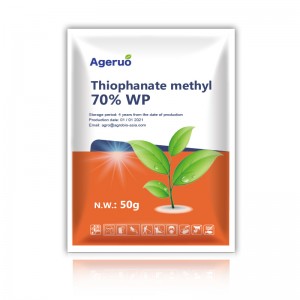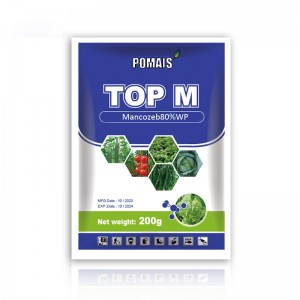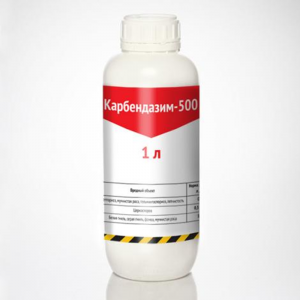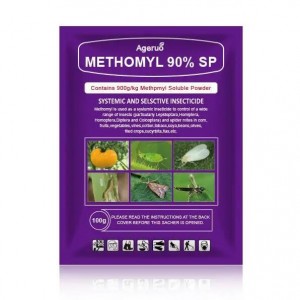Types of fungicides
1.1 According to the chemical structure
Organic fungicides: The main components of these fungicides are organic compounds containing carbon. Because of its structural diversity, organic fungicides can effectively control a variety of diseases.
Chlorothalonil: broad-spectrum fungicide, commonly used on vegetables, fruits and ornamental plants.
Thiophanate-methyl: prevention and treatment of diseases, applicable to fruit trees, vegetables and so on.
Thiophanate-Methyl 70% WP Fungicide
Inorganic fungicides: Inorganic fungicides are mainly composed of inorganic compounds, such as copper, sulfur and so on. These fungicides are widely used in agriculture and have a long residual period.
Bordeaux liquid: prevention and treatment of diseases for fruit trees, vegetables, etc.
Sulfur: traditional fungicide, used for grapes, vegetables, etc.
1.2 According to the source of raw materials of fungicides
Inorganic fungicides: Including copper and sulfur preparations, these fungicides are often used to control fungal and bacterial diseases.
Copper oxychloride: control fungal and bacterial diseases.
Organic sulfur fungicides: These fungicides mainly kill pathogenic bacteria by releasing hydrogen sulfide, commonly used in the control of powdery mildew and other fungal diseases.
Sulfur powder: control of powdery mildew, rust and so on.
Organophosphorus fungicides: Organophosphorus compounds are commonly used in agriculture to control bacterial and fungal diseases, with broad-spectrum and high efficiency.
Mancozeb: broad-spectrum fungicide, control of a variety of fungal diseases.
Organic arsenic fungicides: Although effective, they are now being phased out due to their high toxicity.
Arsenic acid: high toxicity, now eliminated.
Benzene derivatives fungicides: These fungicides are structurally diverse and are commonly used to control a variety of diseases, such as downy mildew and powdery mildew.
Carbendazim: broad-spectrum fungicide, control of fruit trees, vegetables and other diseases.
Azole fungicides: Azole fungicides inhibit the synthesis of fungal cell membranes to kill pathogenic bacteria, widely used in fruit and vegetable disease control.
Tebuconazole: high efficiency, commonly used in fruit trees, vegetable disease control.
Systemic Fungicide Tebuconazole 25% EC
Copper fungicides: Copper preparations have a strong bactericidal effect, commonly used in the control of fungal and bacterial diseases.
Copper hydroxide: control of fruit trees, vegetables and other diseases.
Antibiotic fungicides: Antibiotics produced by microorganisms, such as streptomycin and tetracycline, mainly used to control bacterial diseases.
Streptomycin: control of bacterial diseases.
Compound fungicides: Compounding different kinds of fungicides can improve the fungicidal effect and reduce the resistance of pathogenic bacteria.
Zineb: compound fungicide, control of a variety of fungal diseases.
Crop Protection Fungicides Zineb 80% WP
Other fungicides: Including some new and special fungicides, such as plant extracts and biological agents.
Tea tree essential oil: natural plant extract fungicide, broad-spectrum antibacterial.
1.3 According to the way of use
Protective agents: used to prevent the occurrence of disease.
Bordeaux mixture: made of copper sulfate and lime, it has a broad-spectrum bactericidal effect and is mainly used to prevent fungal and bacterial diseases of fruit trees, vegetables and other crops.
Sulfur suspension: the main ingredient is sulfur, widely used in the prevention and control of many fungal diseases, such as powdery mildew, rust and so on.
Therapeutic agents: used to treat diseases that have already occurred.
Carbendazim: a broad-spectrum fungicide with preventive and therapeutic effects, commonly used in the prevention and control of fruit trees, vegetables and other fungal diseases.
Thiophanate-methyl: It has systemic and therapeutic effects, and is widely used for disease control of fruit trees, vegetables and flowers.
Eradicators: Used to completely eliminate pathogens.
Formaldehyde: used for soil disinfection, with strong sterilization and eradication of pathogens, commonly used in greenhouse and greenhouse soil treatment.
Chloropicrin: a soil fumigant, used to kill pathogenic bacteria, pests and weed seeds in the soil, suitable for greenhouses, greenhouses and farmland.
Systemic agents: Absorbed through plant roots or leaves to achieve whole-plant control.
Tebuconazole: a broad-spectrum systemic fungicide, kills pathogenic bacteria by inhibiting the synthesis of fungal cell membranes, widely used in fruit trees, vegetables and food crops.
Preservative: used to prevent decay of plant tissues.
Copper sulfate: with bactericidal and antiseptic effects, commonly used in the prevention and control of bacterial diseases of plants and to prevent plant tissue decay.
1.4 According to conduction characteristics
System Fungicide: can be absorbed by the plant and conducted to the whole plant, with better control effects.
Pyraclostrobin: a new type of broad-spectrum systemic fungicide with preventive and therapeutic effects, commonly used in fruit trees, vegetables and so on.
Pyraclostrobin Fungicide 25%SC
Non-sorbent fungicide: only play a role in the application site, will not move in the plant.
Mancozeb: a broad-spectrum protective fungicide, mainly used for the control of fungal diseases, will not move in the plant after application.
1.5 According to the specialization of action
Multi-site (non-specialized) fungicides: act on more than one physiological process of the pathogen.
Mancozeb: acts on multiple physiological processes of the pathogen, has a broad-spectrum bactericidal effect, and prevents a variety of fungal diseases.
Single-site (specialized) fungicides: only act on a specific physiological process of the pathogen.
Tebuconazole: It acts on specific physiological processes of the pathogen and kills the pathogenic bacteria by inhibiting the synthesis of the fungal cell membrane.
1.6 According to the different ways of action
Protective fungicides: including contact bactericidal effect and residual bactericidal effect.
Mancozeb: broad-spectrum protective fungicide, used to prevent a variety of fungal diseases.
Sulfur suspension: broad-spectrum fungicide, used to prevent and control powdery mildew and rust.
Systemic fungicides: including apical conduction and basal conduction.
Pyraclostrobin: new broad-spectrum systemic fungicide with preventive and therapeutic effects.
Propiconazole: a systemic fungicide, commonly used in the prevention and control of diseases of cereals, fruit trees and other crops.
Organic Fungicide Propiconazole 250g/L EC
1.7 According to the method of use
Soil treatment:
Formaldehyde: used for soil disinfection, killing pathogenic bacteria in the soil.
Stem and leaf treatment:
Carbendazim: Used to spray plant stems and leaves to control a variety of fungal diseases.
Seed treatment:
Thiophanate-methyl: used for seed treatment to prevent seed germs and disease transmission.
1.8 According to different chemical composition
Inorganic fungicides:
Bordeaux mixture: a mixture of copper sulfate and lime, broad-spectrum fungicide.
Sulfur: widely used in the control of powdery mildew, rust and so on.
Organic fungicides:
Carbendazim: broad-spectrum fungicide, control of a variety of fungal diseases.
Tebuconazole: broad-spectrum systemic fungicide, inhibit the synthesis of fungal cell membrane.
Biological fungicides:
Streptomycin: antibiotics produced by microorganisms, mainly used to control bacterial diseases.
Agricultural antibiotic fungicides:
Streptomycin: antibiotic, control of bacterial diseases.
Tetracycline: antibiotic, control of bacterial diseases.
Plant-derived fungicides:
Tea tree essential oil: natural plant extract with broad-spectrum antibacterial effect.
1.9 According to different types of chemical structure
Carbamate derivatives fungicides:
Carbendazim: broad-spectrum fungicide to control a variety of fungal diseases.
Amide fungicides:
Metribuzin: commonly used for weed control, also has some fungicidal effect.
Six-membered heterocyclic fungicides:
Pyraclostrobin: a new broad-spectrum systemic fungicide with preventive and therapeutic effects.
Five-membered heterocyclic fungicides:
Tebuconazole: broad-spectrum systemic fungicide, inhibits fungal cell membrane synthesis.
Organophosphorus and methoxyacrylate fungicides:
Methomyl: commonly used to control insect pests, but also has a certain fungicidal effect.
Copper fungicides:
Bordeaux mixture: a mixture of copper sulfate and lime, broad-spectrum sterilization.
Inorganic sulfur fungicides:
Sulfur suspension: widely used in the control of powdery mildew, rust, etc..
Organic arsenic fungicides:
Arsenic acid: high toxicity, now eliminated.
Other fungicides:
Plant extracts and new compounds (such as tea tree essential oil): broad-spectrum antibacterial effect, environmental protection and safety.
Form of fungicide
2.1 Powder (DP)
By the original pesticide and inert filler mixed in a certain proportion, crushed and sieved powder. Generally used for powder spraying in production.
2.2 Wettable powder (WP)
It is the original pesticide, filler and a certain amount of additives, in proportion to the full mixing and crushing, to achieve a certain fineness of powder. It can be used for spraying.
2.3 Emulsion (EC)
Also known as “emulsion”. By the original pesticide according to a certain proportion of organic solvents and emulsifiers dissolved in a transparent oily liquid. Can be used for spraying. Emulsion is easy to penetrate the insect epidermis, better than wettable powder.
2.4 Aqueous (AS)
Some pesticides are easily soluble in water, and can be used with water without additives. Such as crystalline lithosulfuric acid, insecticide double, etc..
2.5 Granules (GR)
Made by adsorbing a certain amount of agent with soil particles, cinder, brick slag, sand. Usually the filler and pesticide are crushed together into a certain fineness of powder, add water and auxiliary agent to make granules. Can be spread by hand or mechanically.
2.6 Suspending agent (gel suspension) (SC)
The use of wet ultra-micro-grinding, pesticide powder dispersed in water or oil and surfactants, the formation of viscous flowable liquid formulations. Suspension agent mixed with any proportion of water to dissolve, suitable for a variety of ways to spray. After spraying, it can save 20%~50% of the original pesticide because of rainwater resistance.
2.7 Fumigant (FU)
The use of solid agents with sulfuric acid, water and other substances to react to produce toxic gases, or the use of low-boiling point liquid agents volatile toxic gases, fumigation in closed and other specific environments to kill pests and germs of the preparation.
2.8 Aerosol (AE)
Aerosol is a liquid or solid pesticide oil solution, the use of heat or mechanical force, the liquid dispersed into a persistent suspension of tiny droplets in the air, become an aerosol.
Mechanism of fungicides
3.1 Influence on cell structure and function
Fungicides inhibit the growth and reproduction of pathogenic bacteria by affecting the formation of fungal cell walls and plasma membrane biosynthesis. Some fungicides make the pathogen cells unprotected by destroying the synthesis of the cell wall, which ultimately leads to cell death.
3.2 Influence on cellular energy production
Fungicides can interfere with the energy production process of pathogens through a variety of pathways. For example, some fungicides inhibit glycolysis and fatty acid β-oxidation, so that the germs can not produce energy normally, which ultimately leads to their death.
3.3 Affecting the synthesis of cellular metabolic substances and their functions
Some fungicides act by interfering with the synthesis of fungal nucleic acids and proteins. These metabolic processes are essential for the growth and reproduction of pathogens; therefore, by inhibiting these processes, fungicides can effectively control the occurrence and spread of diseases.
3.4 Inducing plant self-regulation
Certain fungicides not only act directly on pathogenic bacteria, but also induce the plant’s own disease resistance. These fungicides can make plants produce “immune substances” that are specific against pathogens or participate in the metabolism to produce substances that are active against pathogens, thus increasing the plant’s resistance to disease.
Conclusion
Fungicides play an important role in modern agriculture by controlling and preventing plant diseases in various ways. Different types of fungicides have their own characteristics in terms of chemical structure, mode of use, conductive properties and mechanism of action, which makes them widely used in various agricultural applications. The rational selection and use of fungicides can effectively improve the yield and quality of crops and ensure the sustainable development of agricultural production.
FAQ
FAQ 1: What is an organic fungicide?
Organic fungicides are fungicides made of organic compounds containing carbon, which have diverse structures and a wide range of bactericidal effects.
FAQ 2: What are the main types of fungicides?
The main dosage forms of fungicides include powders, wettable powders, emulsifiable oils, aqueous solutions, granules, gels, fumigants, aerosols and fumigants.
FAQ 3: What is the difference between a systemic fungicide and a non-systemic fungicide?
Fungicides can be absorbed by the plant and transmitted to the whole plant, which has better control effect; non-sorbent fungicides only work at the application site and do not move in the plant.
FAQ 4: How do fungicides affect cellular metabolism?
Fungicides inhibit the growth and reproduction of pathogens by interfering with the synthesis of nucleic acids and proteins, affecting the energy production process, and destroying the cell structure.
FAQ 5: What are the advantages of plant-derived fungicides?
Botanical fungicides are made from plant extracts and are generally low in toxicity, environmentally friendly and less likely to develop resistance.
Post time: Jul-01-2024














